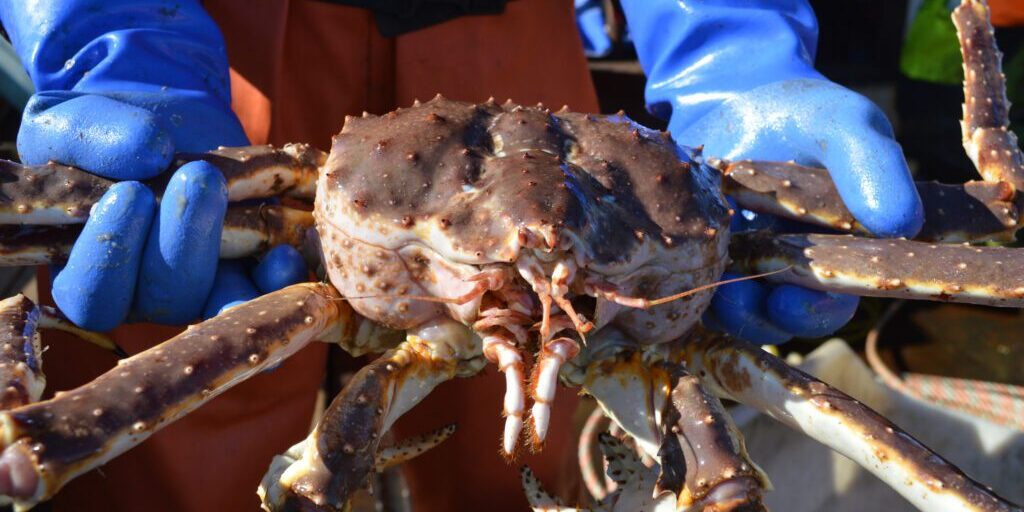The commercial quota for winter Norton Sound crabbers this season is just over 12,000 pounds: less than half of the amount last winter, and about a third of the 2017 quota.
The 150,600-pound commercial quota for the year has 8% reserved for the winter fishery, 7.5% for Community Development Quota (CDQ), and the remainder is for the summer fishery. That equals 12,048 lbs. for commercial winter fishery, and 11,295 lbs. reserved for the CDQ fishery out of the 138,522 lbs for the summer commercial fishery.
Justin Leon, the assistant area management biologist for the Arctic area, based in Nome, explains the decrease has a lot to do with the latest trawl survey results from the Norton Sound.
“We have noticed that we have not detected a new recruitment of younger crab coming up through the population, and from that data is how we come up with estimates for the legal male biomass, and the amount of legal male biomass determines how much quota we have.”
Leon says the Department of Fish & Game did expect the crab population to drop, but not as significantly as they did this year. A dwindling quota may not be the only numbers decreasing ahead of this year’s winter commercial crab fishery.
As of Tuesday (Feb. 19), Leon confirmed that no commercial crabbers had registered with Fish & Game in Nome, less than a week from the start of the season (Feb. 25).
Leon says having no registered commercial crabbers does not happen often this close to opening day.
“(It’s) the first time, at least for me personally, where we don’t have anyone registered getting this close to (the start of) the fishery.”
According to Leon, as of Thursday morning, two commercial crabbers had signed up to fish in the Norton Sound.
The Norton Sound subdistrict covers Nome, Elim, Golovin, and Unalakleet, but the lack of crabbers at this time may indicate unsuitable fishing conditions. According to Leon, winter crabbing can’t happen without sea ice, and currently, sea ice conditions in the Norton Sound are not favorable.
“We see a lot of jumbled ice along the coast from Cape Darby up towards Elim.”
That’s Rick Thoman, a climate specialist with the Alaska Center of Climate Assessment and Policy (ACCAP). Thoman is referencing a high-resolution satellite picture from 12:30 Tuesday, which was taken from the Geographical Information Network for Alaska (GINA) at the University of Alaska–Fairbanks.
“It does look like there is still some shore fast ice from about Elim up into Norton Bay; however, there is some open water there, as well. There’s also some open water trying to poke into Golovin Bay on the west side of the Cape there, but overall, (it) looks like pretty poor ice conditions.”
That area near Golovin Bay, further east in the Norton Sound, produced much more crab last summer than other areas, but Leon says normally successful winter crabbing depends on where ice conditions are good.
During a recent meeting of the Northern Norton Sound Advisory Committee, AC member Jack Fagerstrom of Golovin expressed that due to Elim having no consistent ice coverage, the regional fishery is now becoming a Nome crab fishery. There is not much opportunity for other Norton Sound crabbers to participate.
Whether or not Fagerstrom’s assessment is correct, Thoman says, currently, the sea ice around Elim is jumbled and not stable enough for crabbing, which is unlikely to change anytime soon. There are a series of storms coming to the Norton Sound region over the next week or so.
“So in addition to a lot of south-southeast winds, these storms look to be bringing warmer air than we’ve seen in some of these other storms. Temperatures are likely to be near or above freezing for several days later this week and into the weekend. We aren’t going to melt a lot of ice with that, but that’s definitely not going to help with any kind of ice growth or stabilization.”
The winter commercial crabbing season in Norton Sound begins on Monday and lasts until the end of April, although the Department of Fish & Game has the ability to extend or shorten that by emergency order if needed.
Image at top: Norton Sound red king crab. Photo: Jenn Ruckel, KNOM file.




